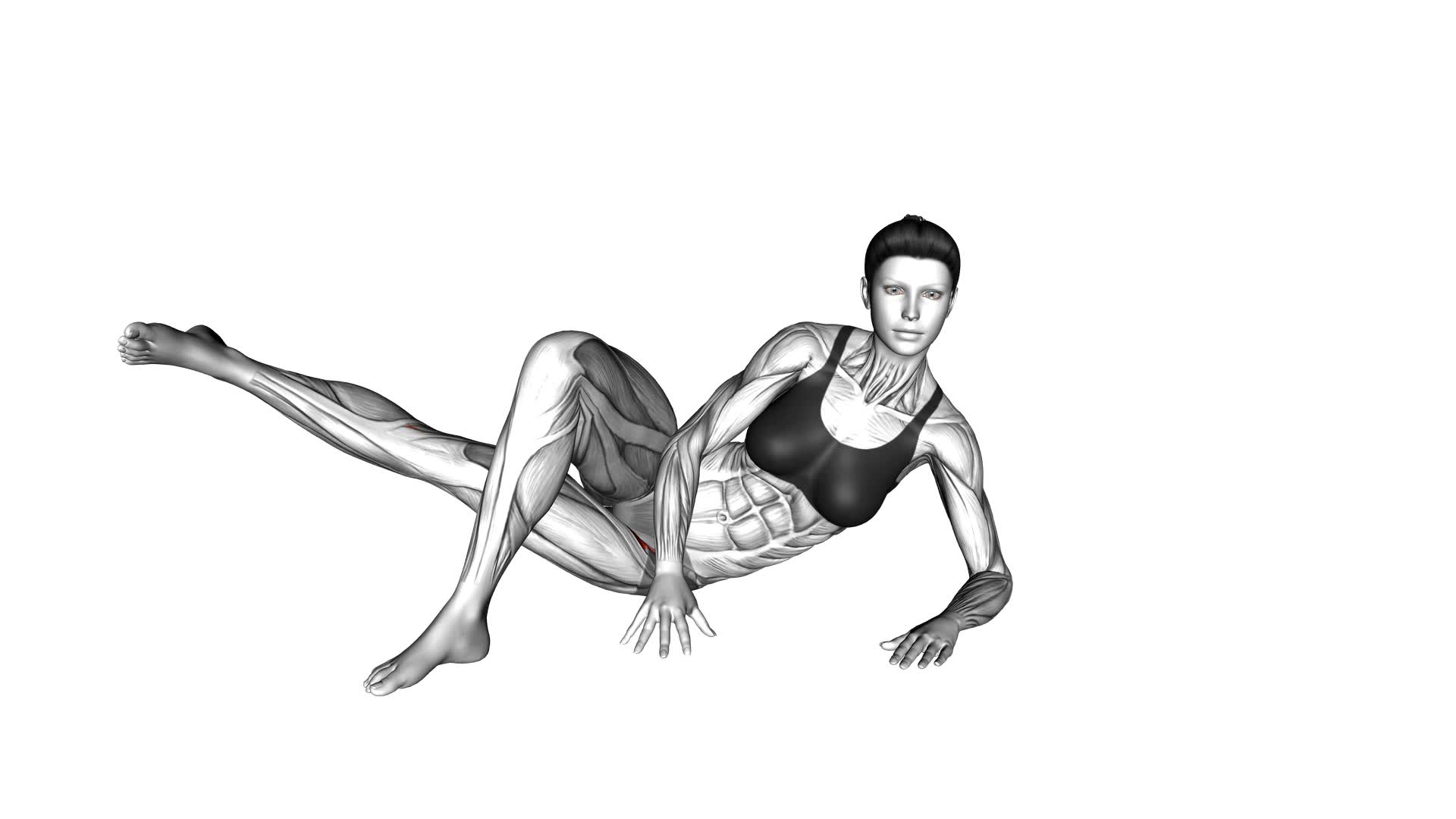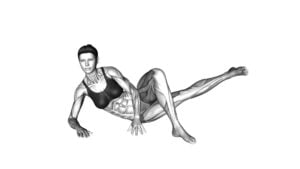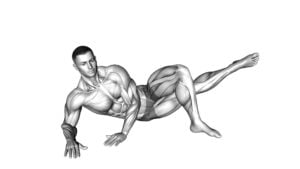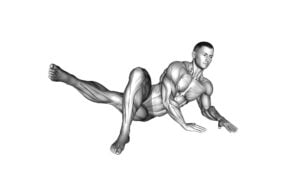Side Lying Hip Adduction (left) (female) – Video Exercise Guide & Tips

Get ready to tone and strengthen your hip muscles with side lying hip adduction. In this video exercise guide, we'll show you the proper form and technique for this effective exercise.
Watch This Exercise Video
You'll also learn common mistakes to avoid and variations to challenge yourself. Whether you're a beginner or advanced, our tips will help you maximize your results.
So grab a mat and let's get started on sculpting those hips!
Key Takeaways
- Side lying hip adduction strengthens and tones the inner thigh muscles.
- Proper form and technique, such as maintaining alignment and engaging the core, are important for effective and safe execution.
- Equipment such as resistance bands, ankle weights, and Pilates rings can be used to increase intensity and target the hip muscles.
- Variations and progressions, such as using a resistance band or incorporating other exercises, can be added to maximize results and challenge the hip muscles.
Benefits of Side Lying Hip Adduction
One key benefit of performing side lying hip adduction is that it strengthens and tones the muscles of your inner thighs. This exercise specifically targets the adductor muscles, which are responsible for bringing your legs together. By regularly incorporating side lying hip adduction into your workout routine, you can increase the strength and definition of your inner thigh muscles.
To maximize your gains from side lying hip adduction, you can try different variations of the exercise. For example, you can add ankle weights to increase the resistance and intensity. Another variation is to use a resistance band around your thighs, which adds extra resistance throughout the movement. These variations will challenge your muscles in different ways and help you achieve better results.
It is important to perform side lying hip adduction with proper form to avoid injury and ensure effectiveness. Make sure to keep your core engaged and your hips stacked on top of each other. Avoid using momentum or swinging your leg, as this takes away from the targeted muscle engagement. Focus on controlled movements and squeezing your inner thigh muscles as you lift and lower your leg.
Now that you understand the benefits and tips for maximizing your side lying hip adduction gains, let's move on to discussing the equipment needed for this exercise.
Equipment Needed for Side Lying Hip Adduction
To perform side lying hip adduction effectively, you'll need a few pieces of equipment. Here are four items that will help you get the most out of this exercise:
- Exercise Mat: A comfortable and supportive exercise mat provides cushioning for your body and helps to reduce any discomfort caused by lying on a hard surface.
- Resistance Band: Adding a resistance band to your side lying hip adduction can help to increase the intensity of the exercise and target your hip muscles more effectively. Loop the resistance band around your thighs to add resistance as you perform the movement.
- Pilates Ring: A Pilates ring, also known as a magic circle, can be used to provide additional resistance and challenge during this exercise. Place the ring between your thighs and squeeze it as you lift your leg, engaging your hip muscles even more.
- Ankle Weights: Ankle weights can be used to add resistance to your side lying hip adduction, making it more challenging and effective. Attach the ankle weights securely around your ankle to increase the workload on your hip muscles.
Proper Form and Technique for Side Lying Hip Adduction
How can you ensure proper form and technique for side lying hip adduction?
Proper form and technique are crucial for getting the most out of your side lying hip adduction exercise. This exercise targets the hip adductor muscles, which are located on the inside of your thigh. By performing this exercise correctly, you can experience several benefits, including increased hip strength and stability, improved posture, and enhanced athletic performance.
To ensure proper form, start by lying on your side with your bottom leg straight and your top leg bent at a 90-degree angle. Place your top foot on the ground in front of your bottom knee for stability. Next, engage your core and lift your bottom leg up towards the ceiling, keeping your knee straight. As you lift, focus on squeezing your inner thigh muscles and maintaining control throughout the movement.
To maximize muscle activation, pay attention to some cues. Imagine that you're pulling your bottom leg towards your top leg, creating tension in your inner thigh muscles. Additionally, focus on keeping your hips stacked and your body aligned throughout the exercise.
By following these guidelines, you can ensure proper form and technique during side lying hip adduction and reap the benefits of this effective exercise.
Now, let's move on to the next section where we'll discuss common mistakes to avoid during side lying hip adduction.
Common Mistakes to Avoid During Side Lying Hip Adduction
When performing side lying hip adduction, it's important to avoid two common mistakes: improper leg positioning and inadequate resistance level.
Improper leg positioning, such as crossing or twisting the legs, can lead to ineffective targeting of the hip muscles.
Similarly, using too light of a resistance level can limit the effectiveness of the exercise and hinder progress.
Improper Leg Positioning
One common mistake to avoid during side lying hip adduction is positioning your leg too far forward or backward. Proper leg alignment is crucial for maintaining hip stability and ensuring the effectiveness of the exercise. Here are four important points to keep in mind to avoid improper leg positioning:
- Align your leg with your body: Make sure your leg is in line with your torso, avoiding any forward or backward deviation.
- Maintain a neutral position: Keep your leg parallel to the floor, avoiding any rotation inward or outward.
- Engage your core: Activate your core muscles to stabilize your hips and maintain proper leg alignment throughout the movement.
- Focus on the hip joint: Direct your attention to your hip joint and ensure that it remains stable and centered during the exercise.
By following these guidelines, you can maximize the benefits of side lying hip adduction and prevent potential injuries.
Now, let's move on to the next section, which discusses the issue of inadequate resistance level.
Inadequate Resistance Level
To maximize the effectiveness of side lying hip adduction, ensure that you're using an appropriate level of resistance. One common mistake to avoid is using inadequate resistance levels. When the resistance is too light, you won't challenge your muscles enough to see significant progress. On the other hand, using resistance that's too heavy can lead to improper form and potential injury.
For beginners, it's important to start with a resistance level that allows you to perform the exercise with proper technique and control. As you gain strength and confidence, you can gradually increase the resistance to continue challenging your muscles.
Variations and Progressions of Side Lying Hip Adduction
To progress the side lying hip adduction exercise, you can add resistance bands or ankle weights for added challenge and muscle activation. Here are four variations and progressions of the side lying hip adduction exercise:
- Resistance bands: Attach a resistance band around your thighs, just above your knees. This will increase the resistance and make the exercise more challenging. As you lift your top leg, you'll feel the resistance from the band, which will further engage your hip abductors.
- Ankle weights: Strap on ankle weights to add extra resistance to your leg as you perform the side lying hip adduction. This will require more effort from your hip abductors, making them work harder to lift and lower your leg.
- Medicine ball squeeze: Place a medicine ball between your thighs and squeeze it as you lift your top leg. This won't only target your hip abductors but also engage your inner thigh muscles. The added pressure from the medicine ball will intensify the exercise and challenge your muscles even more.
- Single-leg side lying hip adduction: Instead of lifting both legs together, focus on lifting one leg at a time while keeping the other leg extended. This variation increases the demand on your hip abductors and adds an element of balance and stability to the exercise.
Incorporating these variations and progressions into your side lying hip adduction routine will help you continually challenge and strengthen your hip abductors for optimal results.
Tips for Getting the Most Out of Side Lying Hip Adduction
To get the most out of side lying hip adduction, it's important to focus on proper form techniques and muscle activation cues.
Ensure that your body is aligned correctly throughout the exercise, with your hips stacked and your core engaged.
Additionally, concentrate on activating the muscles of the inner thigh as you perform the movement, squeezing them tightly with each repetition.
Proper Form Techniques
Maximize your results with side lying hip adduction by using proper form techniques. Follow these tips to ensure optimal muscle engagement and make the most out of this exercise:
- Alignment: Lie on your side with your hips stacked, and keep your body in a straight line from head to toe. This will help maintain proper form and prevent any strain on your back.
- Core Activation: Engage your core muscles by pulling your belly button towards your spine. This will provide stability and support during the movement.
- Controlled Movement: Slowly lift your top leg towards the ceiling, focusing on using the muscles on the side of your hip. Avoid swinging or using momentum to perform the exercise.
- Modifications: If you find the exercise too challenging, you can use a resistance band around your thighs or perform the movement with your knees bent. This will help decrease the intensity while still targeting the hip muscles effectively.
Muscle Activation Cues
Engage your hip muscles more effectively by focusing on proper muscle activation cues during the side lying hip adduction exercise. By paying attention to these cues, you can maximize the benefits of this exercise and ensure that you're targeting the right muscles.
First, make sure to maintain proper alignment throughout the movement. Keep your body in a straight line from head to toe, and avoid any excessive twisting or tilting of the hips. This will help you isolate the hip muscles and prevent any unnecessary strain on other areas.
Next, focus on initiating the movement from the hip joint itself. Imagine squeezing your inner thigh muscles together and pulling your leg towards your midline. This will help you activate the adductor muscles more effectively.
Lastly, be mindful of your breathing. Inhale as you prepare for the movement, and exhale as you perform the adduction. This will help you engage your core and stabilize your body during the exercise.
Frequently Asked Questions
How Many Sets and Reps Should I Do for Side Lying Hip Adduction?
To determine the number of sets and reps for side lying hip adduction, you should consider your fitness goals and current fitness level.
Hip adduction variations, like side lying hip adduction, can help strengthen the inner thigh muscles, improve hip stability, and enhance overall lower body strength.
Start with 2-3 sets of 10-15 reps per side, and gradually increase as you get stronger.
Remember to maintain proper form and listen to your body to prevent injury.
Can I Do Side Lying Hip Adduction if I Have a Hip Injury?
If you have a hip injury, it's important to be cautious when performing side lying hip adduction. This exercise can put strain on the hip joint, so it may not be recommended.
Instead, focus on hip adduction modifications or alternative exercises that are safe and won't exacerbate your injury.
Consult with a medical professional or a qualified trainer to determine the best course of action for your specific situation.
Is Side Lying Hip Adduction Suitable for Beginners?
Side lying hip adduction is a suitable exercise for beginners looking to strengthen their hip muscles. It targets the adductor muscles, which are important for stability and mobility.
To perform this exercise, lie on your side with your legs stacked and slowly lift your top leg towards the ceiling. Avoid common mistakes like using momentum or lifting your leg too high.
With proper form and control, side lying hip adduction can be a beneficial workout for beginners.
Can Side Lying Hip Adduction Help With Reducing Love Handles?
Side lying hip adduction is one of the best exercises for reducing love handles. By targeting the outer thighs and hips, this exercise helps to strengthen and tone those areas, leading to a more defined waistline.
In addition to its aesthetic benefits, side lying hip adduction also improves hip stability and overall lower body strength.
How Long Does It Take to See Results From Side Lying Hip Adduction?
To see results from side lying hip adduction, it depends on various factors such as your current fitness level, consistency, and diet.
By consistently performing this exercise with proper form, you can engage and strengthen the muscles in your hips and thighs.
Over time, you may notice improvements in hip stability, muscle tone, and overall lower body strength.
Remember to consult with a fitness professional to ensure you're performing the exercise correctly for maximum benefits.
Conclusion
In conclusion, side lying hip adduction is a beneficial exercise for strengthening the hip muscles. By using proper form and technique, you can target the adductor muscles effectively. Avoid common mistakes and progress in difficulty to challenge yourself.
Remember to use the necessary equipment and follow the tips provided to maximize the benefits of this exercise. Incorporate side lying hip adduction into your fitness routine to improve hip strength and stability.

Author
Years ago, the spark of my life’s passion ignited in my mind the moment I stepped into the local gym for the first time. The inaugural bead of perspiration, the initial endeavor, the very first surge of endorphins, and a sense of pride that washed over me post-workout marked the beginning of my deep-seated interest in strength sports, fitness, and sports nutrition. This very curiosity blossomed rapidly into a profound fascination, propelling me to earn a Master’s degree in Physical Education from the Academy of Physical Education in Krakow, followed by a Sports Manager diploma from the Jagiellonian University. My journey of growth led me to gain more specialized qualifications, such as being a certified personal trainer with a focus on sports dietetics, a lifeguard, and an instructor for wellness and corrective gymnastics. Theoretical knowledge paired seamlessly with practical experience, reinforcing my belief that the transformation of individuals under my guidance was also a reflection of my personal growth. This belief holds true even today. Each day, I strive to push the boundaries and explore new realms. These realms gently elevate me to greater heights. The unique combination of passion for my field and the continuous quest for growth fuels my drive to break new ground.



